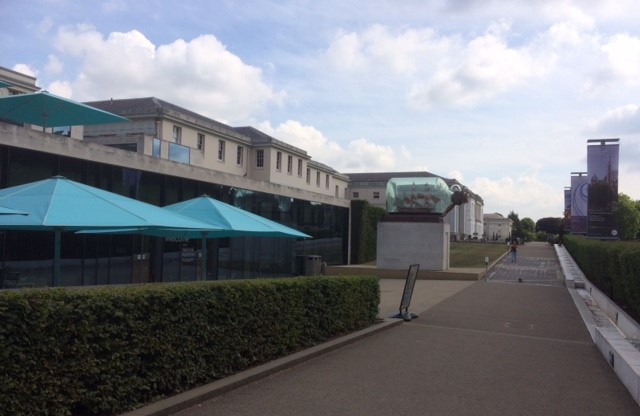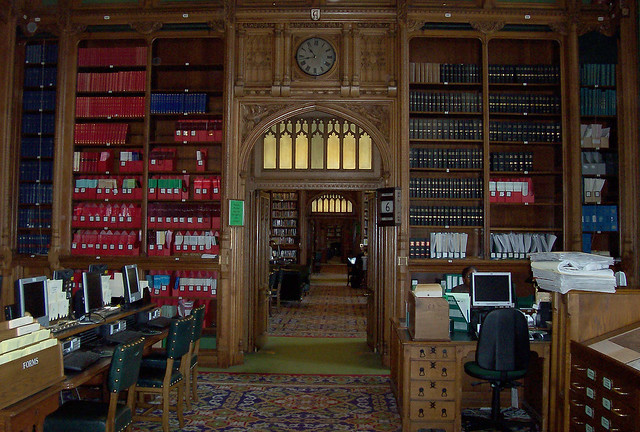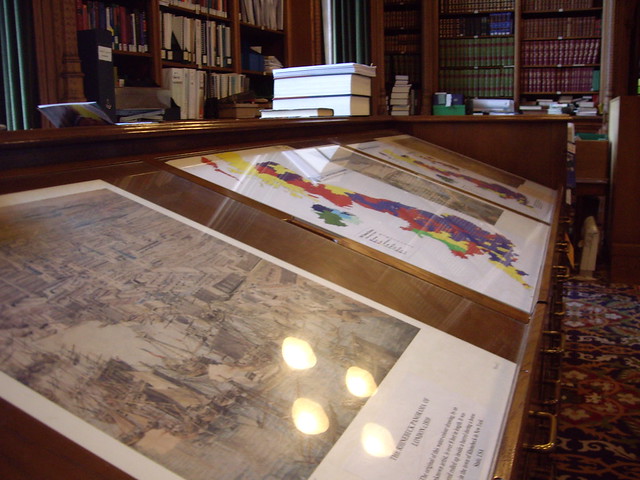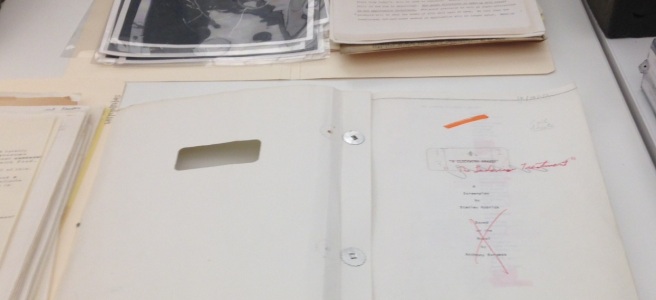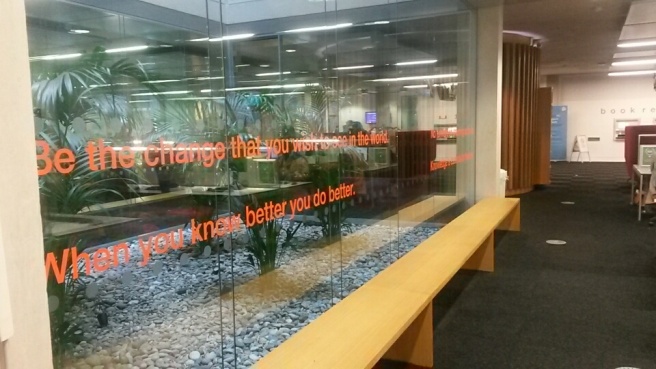INT.
On a cold and drizzly Monday morning in April a group of Information Professionals congregate at the London College of Communication.
SETTING
A selection of Archive materials are presented on tables in the Archive and Special Collections reading room.
The archive adheres to National Guidelines to preserve and protect original material (PD5454). Bags and pens are safely stored away.

DIALOGUE
Georgia and Sarah greet the group and provide an inspiring account of the Stanley Kubrick archive; the history, acquisition, preservation and use.
BACKGROUND
The University of the Arts (UAL) acquired the Stanley Kubrick archive in 2007. This coincided with the establishment of a reading room which brought together approx. 30 collections from across the University’s six campuses. A number of collections remain in the libraries, i.e. Artists’ Books at Chelsea College of Art.
A growing emphasis on object-based learning is evident with inclusion of the archive in a number of course syllabuses.
The archive receives 1,400 – 1,700 visitors per annum. The reading room accommodates up to 6 researchers.
Stanley Kubrick was born in New York in 1928 however lived most of his life in the UK where he made a majority of his films. In total Kubrick completed 12 films between the 1950s- 90s, spending an increasing amount of time on pre-production research. Kubrick passed away in 1999 soon after completing the post-production of Eyes Wide Shut. The archive documents Kubrick’s work (both released and unmade films) and does not contain material pertaining to the director’s personal life.
For more on the history of Kubrick’s archive see this insightful documentary by Jon Ronson:
___________
PROPS
Lolita (1962)
Press Invitation. Flatpack cube featuring Bert Stern’s risqué photographs of Sue Lyon as Lolita at aged 16. Stern’s transparencies were also on display.
Quigley’s Suggestions. Document advising Kubrick on which changes should be made to ensure the film passes the certification process. Evidence of how morals have changed over time, for instance it is recommended Kubrick cut a scene showing an insult to a police officer,an incident not uncommon in contemporary cinema.

Dr Strangelove or: How I Learnt to Stop Worrying and Love the Bomb (1964)
Press Invitation. Top Secret dossier containing press release and Nuclear Bomb Effects Computer. Build your own.

Space Odyssey 2001 (1968)
Set and Prop Design Drawings. Kubrick approached large corporations inviting each to design products they envisioned would be marketable in 2001. These products were used on set and the inclusion of brand logos is an early example of product placement in film.
IBM designed the on-board computers however later withdrew upon reading the plot. It is rumoured that the Kubrick changed the brand to ‘HAL’ (1 letter difference) in response.
Clockwork Orange (1971)
Annotated Script. Corrections aptly handwritten in orange ink. Kubrick was quarrelling with Anthony Burgess at the time and has crossed his name through. Insight into the process of film-making and example of Kubrick’s methodology. The script does not lead Kubrick’s process.

Barry Lyndon (1975)
Source Material. Ringbinder containing fabric cuttings and reproductions of 18th century portrait paintings. Described as Kubrick’s most painterly film, the research material demonstrates the importance of authenticity on set.
Also known for its unique lighting- filmed using adapted lens designed by NASA. Shot in natural daylight and by candlelight, cast required to traverse set in slow motion as if they had ‘swallowed a broom’.
The Shining (1980)
Advertising Campaign in collaboration with Saul Bass. From early sketches to final film posters. Early mock-ups inspired by Hitchcock evolved into a modern aesthetic. Displayed alongside correspondence between Kubrick and Bass.
All work and no play makes Jack a dull boy handtyped papers. The Archive owns several copies of these papers. For continental releases, Kubrick’s team researched proverbs on work and diligence and replaced the original phrase for this key scene to preserve impact.
i.e. Spanish release translates to ‘Waking up earlier won’t make the sun rise any quicker.’
Italian release translates to ‘the morning has gold in its mouth’
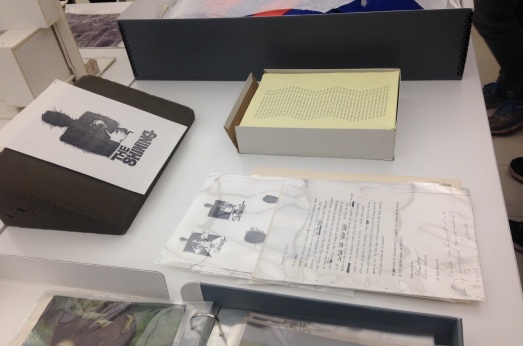
Costume: Danny Torrance. Jacket and jumper. Originally purchased from high street stores and packed away in cardboard boxes. UAL conservation students worked in collaboration with Archivists to pack costumes in tiered conservation boxes.
Full Metal Jacket (1987)
Location Photographs decorated with art department’s annotations and proposed additions to transform London industrial estate to Vietnam warzone.
Eyes Wide Shut (1999)
Architectural model of New York street. Highly detailed with miniature newspapers inside shop window.
File of photographs. Gates of stately homes in the UK taken by Kubrick’s nephew as part of pre-production location research.

___________
Art inspired by the Archive
Foundation degree students produced a set of colouring-in books based on Kubrick’s films. Each page shows an illustration of a film still.
Jane and Louise Wilson film project based on Kubrick’s Aryan Papers project- http://www.animateprojects.org/films/by_project/residencies/kubrick
Copyright Permissions
The rights are owned by the Kubrick estate. Researchers wishing to use photographs of items from the collections in publications are requested to submit an application.
Recommended Publication
Stanley Kubrick: New Perspectives. ISBN: 9781908966421
Travelling Exhibition
A selection of material from the archive forms part of a travelling exhibition that is currently on display in San Francisco. The next venue will be Mexico City. UAL representatives attend the private views and occasionally organise research symposiums to coincide.
Other Collections of interest to filmmakers at UAL
Tharold Dickinson (1903 – 1984) Film director and educator.
John Schlesinger (1926 – 2003) film director and author.
Tom Eckersley (1914 – 1997) graphic designer and educator.
Clive Exton (1930 – 2007) screenwriter for armchair theatre, work includes Poirot and Jeeves and Wooster.
Sound Art Archive: ‘HerNoise’ Sound Art Archive containing 60 videos, 300 audio recordings, 40 books/ catalogues and 250 Zines. Inclides ‘Reverse Karoke’ inviting observers to produce sound not lyrics.
London Musicians Collective research into sound art practice.
___________
Donations Policy
UAL consider the size, material and significance of material to decide whether to accept. They also require support from academic colleagues as material must be of use to staff and students.
Classification
The Stanley Kubrick Archive is shelved according to the production process: Research> Pre-Production> Production> Post-Production>Promotion>Post-Distribution.
Recommendations for Starting an Archive Collection
- Be flexible – allow room for growth
- Have a range of storage facilities: hanging walls, plan chests and rolling stacks
- Monitor environment regularly – use devices such as a humbug

___________
The Archives and Special Collections website:
http://www.arts.ac.uk/study-at-ual/library-services/collections-and-archives
The Archives and Special Collections Catalogue: http://archives.arts.ac.uk/Calmview/default.aspx
___________
Towards a Rhizomatic Library
Following the Archive, I visited the Library where students has organised a ‘string experiment’. In this participative experiment, Interaction Design Arts students had asked their peers to leave post-its in sections of the library where they stop. These ‘stops’ were recorded and visually translated using string.
‘Our installation aims to remind us about the many users and uses of the library, celebrating it as a place where connections are made.’

Write-up by Rebecca Daniels, CILIPinKent Communications Officer










